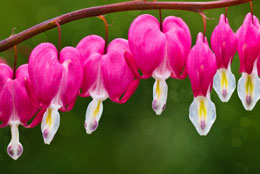The Dicentra spectabilis is one of the cold climate plants, known for its unique, heart-shaped flowers. The information about this flowering plant is provided, in short, in this article.

The Dicentra spectabilis is a flower plant which is perennial in nature and commonly known as bleeding heart. Other names of this perennial herb are Dutchman's trousers, Venus's car and lyre flower. It is basically a flowering plant, native to eastern parts of Asia and it inhabits the region that stretches from Japan to southern Siberia. Flowering season of this species starts in spring and lasts till mid-summer. The Dicentra spectabilis was introduced in England in the year 1810. However, before any kind of commercial cultivation occurred, the plant died out. Robert Fortune, a plant explorer who visited China in 1846 reintroduced the plant in England. He was sent to bring the bleeding heart plant by the Royal Horticultural Society.
Fatcs about Dicentra Spectabilis
This plant grows in cool as well as warm climates. Once the roots are well established in soil, the plant requires very less maintenance. The height attained by this flowering plant is between 24 - 36 inches. The expanse of branches and leaves is around 12-18 inches. The plant produces ternately compound leaves and pendulous flowers. The ternately arranged leaves grow in groups of three and have a smooth surface; color of the leaves are light green. The raceme inflorescence of bleeding heart arranges flowers along a central axis of the twig. This plant produces flowers with white (inner) and pink (outer) petals and the stems of this plant form arches. The flowers are heart-shaped and arched stems make them appear to be dangling from the twig along its central axis.
Care Maintenance
The Dicentra spectabilis plant if grown in warm climatic conditions, should be provided with a shady and cool area. The soil pH level should be between neutral and alkaline. Though, the plant ideally needs well-drained soil, it can also flourish in heavy soils. Even if it needs a well drained soil, some amount of moisture needs to be retained for its proper growth. The soil that is rich in the humus is best for the growth of bleeding heart. The bleeding heart plant need to be protected from pests such as slugs, aphids and snails. These pests might cause damage to the leaves and retard the growth of the plant. The soil surrounding this plant should be mulched in autumn for which one can use compost or leaf mold which is readily available for mulching. The leaves of bleeding heart plant that are near to the surface soil, should be trimmed in summer. The practice of transplanting creates disturbances in the growth of this plant.
Seeds of Dicentra Spectabilis
The seeds of this plant fall in the category of hardy perennials. Its hardiness zone is between 3 and 9. Sowing of seeds should be done before they dry out. One should sow the seeds of this plant in the fall season. The initial freezing temperature required by seeds is provided in this season by the mother nature itself. One can even plant the seeds indoors in pots. Sowing the seeds in a pot and storing in freezers for 6-8 weeks, serves the purpose. After this initial freezing period, the seeds are ready to grow outdoors.
The leaves of bleeding heart are used for edible and medicinal purpose. The floral can be used in bouquets and in the form of cut flowers for the decoration purpose. The Dicentra spectabilis flowers are attractive in appearance and therefore have a good commercial value. One can grow them at home in flower gardens since, the maintenance required is less. The information about the bleeding heart provided above, would prove to be helpful.






 The Dicentra spectabilis is a flower plant which is perennial in nature and commonly known as bleeding heart. Other names of this perennial herb are Dutchman's trousers, Venus's car and lyre flower. It is basically a flowering plant, native to eastern parts of Asia and it inhabits the region that stretches from Japan to southern Siberia. Flowering season of this species starts in spring and lasts till mid-summer. The Dicentra spectabilis was introduced in England in the year 1810. However, before any kind of commercial cultivation occurred, the plant died out. Robert Fortune, a plant explorer who visited China in 1846 reintroduced the plant in England. He was sent to bring the bleeding heart plant by the Royal Horticultural Society.
The Dicentra spectabilis is a flower plant which is perennial in nature and commonly known as bleeding heart. Other names of this perennial herb are Dutchman's trousers, Venus's car and lyre flower. It is basically a flowering plant, native to eastern parts of Asia and it inhabits the region that stretches from Japan to southern Siberia. Flowering season of this species starts in spring and lasts till mid-summer. The Dicentra spectabilis was introduced in England in the year 1810. However, before any kind of commercial cultivation occurred, the plant died out. Robert Fortune, a plant explorer who visited China in 1846 reintroduced the plant in England. He was sent to bring the bleeding heart plant by the Royal Horticultural Society.